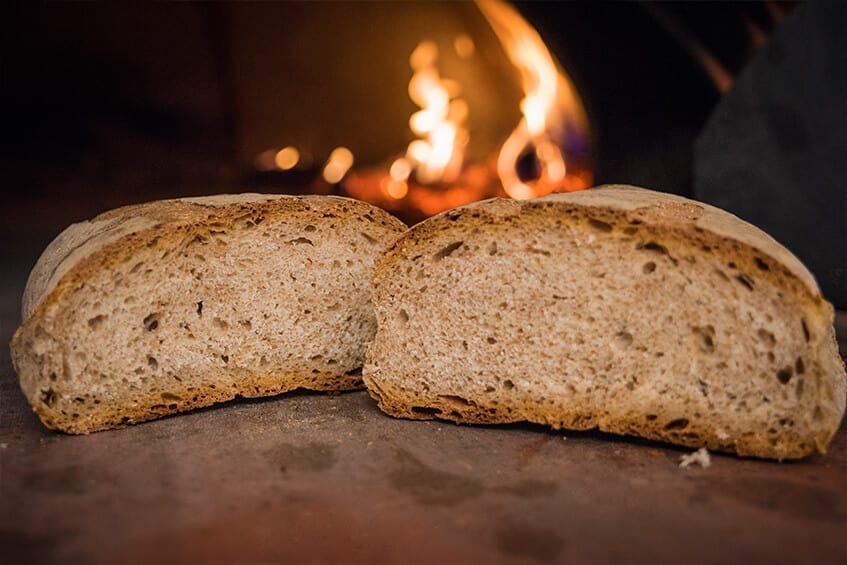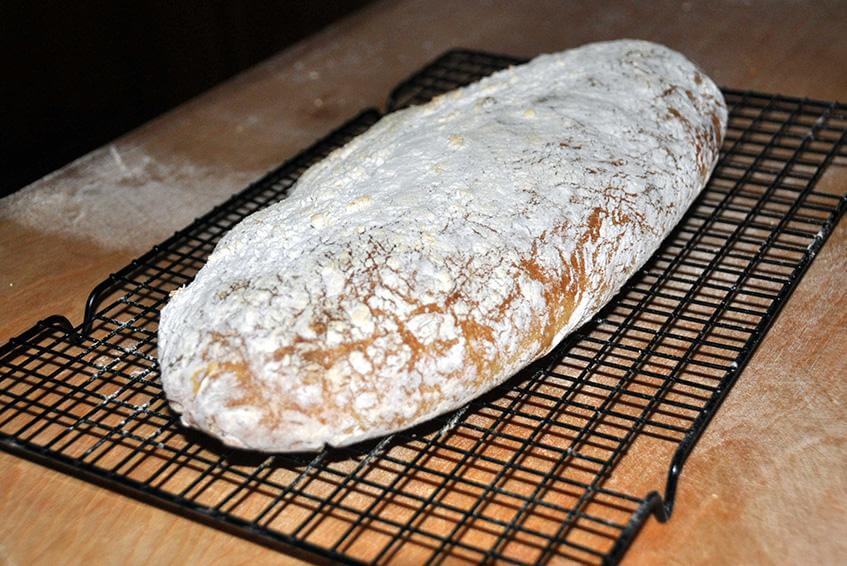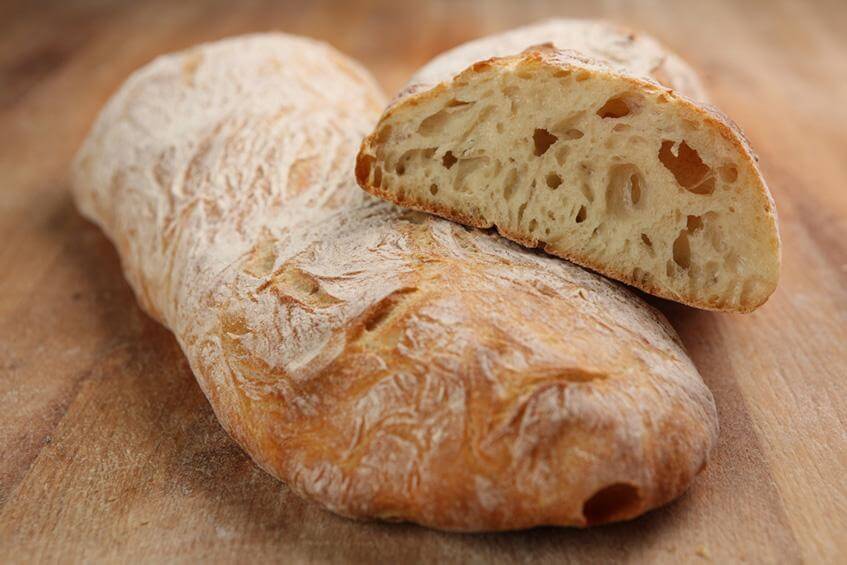Baking home-made bread is an old passion that is being rediscovered. Bread has been a staple in the diet of many earlier civilizations and at its simplest can be boiled down to two ingredients: grain flour and water. Making bread is not hard but it can be daunting, especially when it comes to make dough or, more often, to bake it. Easy-peasy with gas or electric ovens and a bit more challenging if you use a wood-burning oven. So, in this article you will find a step-by-step guide to make bakery-quality bread at home, focusing on the differences between pizza dough and bread dough and learning how to cook like a pro with a wood-fired Alfa oven.
Bread and pizza: the differences.
Bread is the most widely consumed food in the world, it comes in numberless forms and can be made from many types of flour with distinct geographical varieties. In Italy, for instance, the Mediterranean climate has favoured the spread of more than 1 200 varieties of wheat, most of which are good for bread-baking. Bread, especially when baked in a wood-burning oven, has a significance that goes far beyond the mere nutritional aspect and embraces cultural and religious elements as well. Pizza is made with the same ingredients and tossing some pizza dough into a wood-fired oven to test the temperature before baking bread is still pretty common. Pizza is relatively young compared to bread but has come a long way since the late 19th century and is now one of the most favourite food.
Here are the main differences between bread and pizza
- Bread is a symbol that unites most of the world civilizations and is a cheap source of energy and nourishment even for poorer strata of society.
- Bread, in all its various forms, puffs up while pizza remains thin during baking. So, to bake a perfect loaf through to the centre you will need more time while pizza comes into direct contact with the oven floor and will be done in a few minutes.
- There are few ingredients that you really need to make bread even though it may sometimes contain spices, fruits, nuts or seeds but what you surely can’t do is to top it with nearly anything edible like a pizza.
- The hydration of dough is lower for bread (50-60%) to produce a denser and closed crumb, a longer shelf life and to help it hold its shape during baking.
- Traditionally, bread is baked in the wood-fired oven after the embers and ash are swept out of the floor and the heat is given off by the oven walls as they cool. On the contrary, pizza is cooked in a few minutes by direct heat from the fire.
How to make bread at home
Making bread is much easier than you might think; you just need some basic ingredients and to be careful not to make mistakes when making bread dough and baking it. In this regard, we refer you to our blog’s article on how to make a terrific pizza dough and how to bake it perfectly.
Four factors to make great bread dough
Quality of raw materials
It’s as simple as that! To get a quality product you need high-grade ingredients (a more expensive flour or mineral water instead of tap water can really make the difference).
Right amount of ingredients
We suggest that you lower the quantity of yeast and lengthen the fermentation process to give the gluten network more time to grow.
Types of dough
A low-hydration dough involves a ton of kneading to get the flour incorporated and the gluten developed.
Proofing
Unlike pizza dough, bread dough is not stretched and divided but it’s shaped into a loaf and baked.
Watch this vivalafocaccia.com video to learn how to make bread and bake it in an Alfa wood-fired oven.
How to bake perfect bread at home
Oven temperature
Usually bread is baked at 220°C, a temperature lower than that of pizza, until it’s done in the middle and crispy on the bottom.
Humidity of cooking chamber
Humidity is an all-important parameter in the production of bread. Steam helps keep the crust soft in the first minutes of baking so the bread can get the final expansion. A good idea is to humidify the cooking chamber before baking because bread releases moisture during cooking to keep up to scratch the level of humidity in the oven.
Cooking time
Cooking time depends on how big the loaves are and on how hot the oven is. Every oven performs differently so don’t be afraid to experiment to find the right balance between time, temperature and humidity.
Type of oven
The type of oven does affect your cooking. You may have read our blog to find out how to adapt pizza dough to the oven. Generally speaking, electric and gas-fired ovens are easier to use than wood-fired ovens whose performances are nevertheless well above par.
Quality of the oven
Whatever the oven you choose, make sure that it is of good quality, built with solid materials and with high thermal mass.

How to bake bread in a wood-burning oven
Wood-fired oven is a formidable cooking tool when you get a handle on the way it works. Cooking with wood infuses food with very rich flavours and allows you to develop your baking skills. As we have seen above, to make good bread, you must find the right chemistry between the bread size, the baking time, the temperature and the humidity of the oven. To clarify this, let’s consider baking breads of different sizes:
- If you bake, say, a 1 kg loaf:
- increase the oven humidity
- delay the bake until the temperature drops to 210°C
- lengthen cooking time until the bread is well done in the middle, wetting the oven floor with a damp cloth a few minutes before baking.
- If you bake a 500 g loaf:
- no need to humidify the oven because the excess steam could form a very thin crumbly crust.
- bake at a higher temperature (around 220°C).
- shorten baking time and don’t hydrate the oven floor to delay the hardening of the crust.
Let’s not forget that bread is baked in a wood-fired oven after the embers are cleared of the floor with the door ajar so that the temperature goes down slowly and steadily. Cook some pizzas at 450°C to start the party and then bake the bread when the temp drops down to 220°C. After making home-made bread, make sure to cool it properly to keep it in tip-top shape. For example, put the bread onto a cooling rack resting on four upside-down glasses to avoid that residual moisture condenses into the crumb making it soggy and sponge-like.

Cooking with Alfa wood-fired oven
Cooking with a wood-fired oven is not so hard but it’s a process that demands a trial-and-error approach needing continuous tweaking until you know the oven workings inside out. Maybe you are entertaining the idea of changing your appliance, then what about buying a high-performance home professional oven? Alfa ovens can bake bread as well as pizza, they are able to optimize cooking time and consumption thanks to the fast heating steel dome and come in models many and various. Models such as Ciao, the compact oven, the huge Allegro, the bigmouthed 4 Pizze or the fully refractory true to tradition Cupolino have nothing left to prove. Alfa provides the best ovens for every cooking needs.



